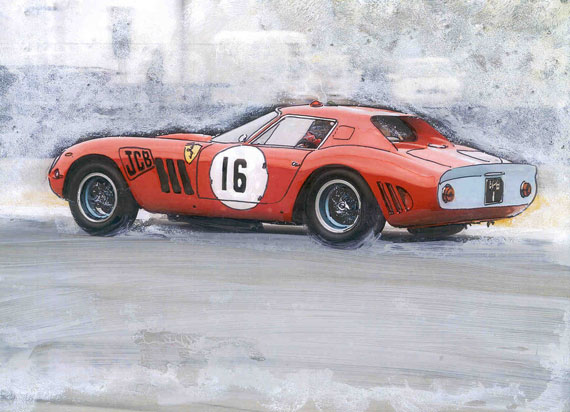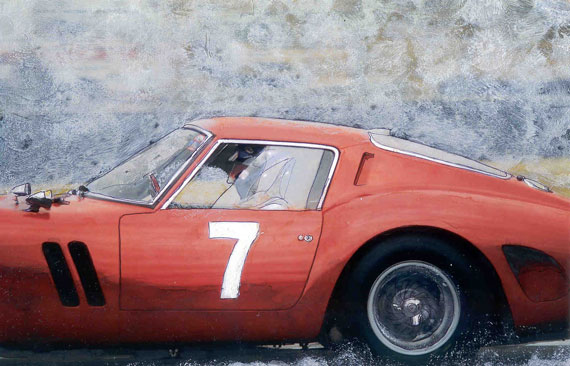By Wallace A. Wyss
Illustrations: Original paintings by the author. Prints available from www.albaco.com
Ask any Ferrari enthusiast what is the greatest Ferrari and most will say 250GTO.
That’s because the GTO was one of the last great street cars that could do equally well on the track. Only one year after the GTO, Ferrari was building the 250LM, a mid-engined car, and from then on, most serious race cars were mid-engined.
The Ferrari GTO descended from the Ferrari 250 GT. even going back nine years earlier to the Europa GT. That evolved into the 250 GT SWB (for Short Wheel Base) and Giotto Bizzarrini was brought in and given the time and money to first make a Comp swb and then later to modify it to beat the threat of the Cobra. Thus was born the GTO.
Shelby’s Cobra could go 150 mph even in its brick-shaped form as a roadster. Ferrari knew Shelby was planning a coupe (which was built, ironically, in Modena after the prototype was done in California.). So Ferrari let Bizzarrini have his way. Bizzarrini shifted the engine position, added dry sump and a 5-speed and began running a mule at night, in high speed runs down the Autostrada, changing the nose each night, until he got the car up to 170 mph, enough to blow off the Cobras.
Ferrari was supposed to make 100 of them to homologate it as a production car but he slid it by the FIA saying it was just a body variation on the already homologated swb 250GT.
Shelby complained louder than most about this outright trickery and the FIA punished Ferrari in ’64 by refusing to homologate the 250LM as a production model, but ironically one co-driven by an American who had been bounced from the Ford team still beat the Ford factory’s GT40s at LeMans in ’65.
When those 250GTOs are lined up on the green at Pebble it will probably mark the most expensive lineup on the green per model ever, unless you count the Bugatti Royales they corralled a few years ago. One price we found a GTO sold for in recent years was $15 million but other say one failed to sell at $7 million plus change, but since so few change hands it is a difficult car to price.
The author hates to write about this car’s price. In 1969 when he reported for work at Bond Publishing in Newport Beach, CA a fellow worker offered him a tatty one for $18,000. The author turned it down; after all it was smokey.
There were only 36 250GTOs but as you look at the history you wonder, should the 330-engined ones (like the 330 LMB, below) be included? What about the “anteater” prototype (above)? Or the engineering prototype with 400SA style body that ran at LeMans in ’61? This argument will never die out, not as long as there are Ferrari historians who pride themselves on the most arcane details.
Perhaps only Pebble, among all Concours events, could pull this off. They have the most prestigious judges, and the reputation for a win at Pebble actually improving a car’s value. Whether that will make all 39 owners spend what it takes to get their car to Pebble next August remains to be seen….


Hi Wally
Nice article and thanks for your kind words. I hope that we will get as many GTOs as we can…its looking good so far!
Best wishes
Nic
Wally,
Only 36 250 GTs were constructed. Two 4-liter cars were also built, one LM and one SA. So you could say 38 total. Which is why your confused.
CQ
MORE photos PLEASE
The best looking Ferrari EVER
Chuck,
Bluemel/Pourret has it as 36–I know the number varies depending on what is
counted though.
For the record, let’s agree on 36 250GTOs and I’ll correct the text—
Pete
In 1965 in between my freshman and sophomore year at Tulane, my father said he had been behind a funny looking red car bouncing all over the brick streets in the warehouse district of New Orleans. It had a GTO badge on its rear. I knew Ferrari had never put such a badge on a car, but still called a friend and we went to investigate. Sportscars Inc. had a 1964 LM bodied GTO (somebody had robbed a Pontiac for the badge) in the back, probably fresh from the Daytona 2000 km race, for sale at $12,000. The two of us could have scraped up about $300 between us so it stayed on Magazine Street. I did get to sit in it, however.